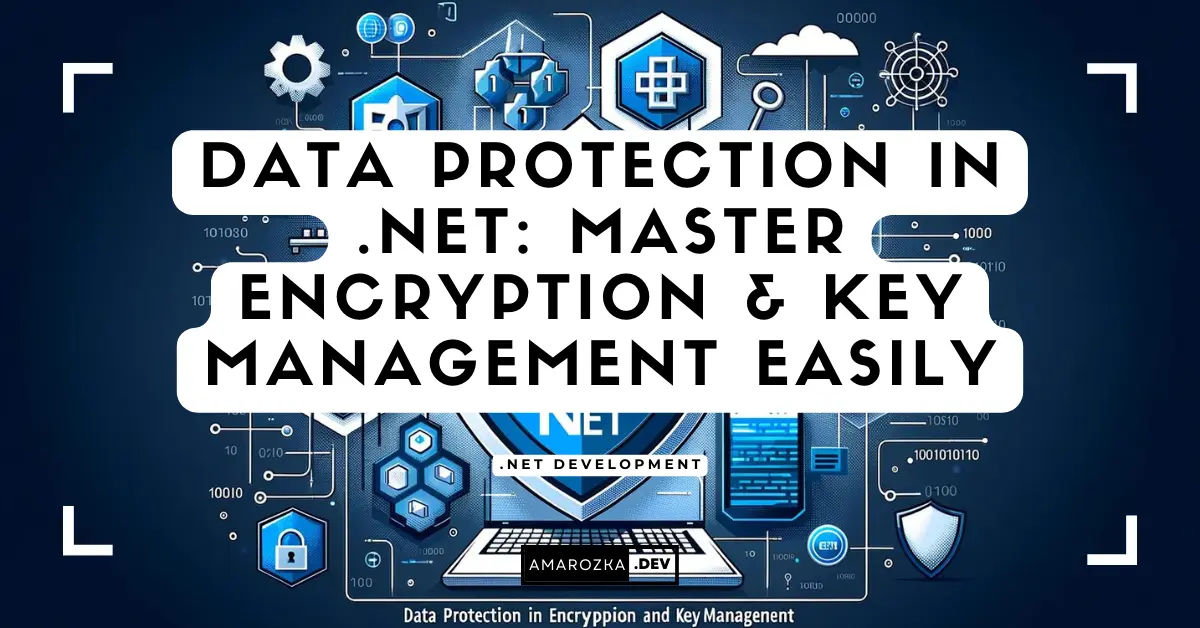Are You Sure Your .NET App Encrypts Data the Right Way? You encrypt your app’s data—great! But is it secure, or just encrypted? There’s a big difference. Most devs unknowingly leave the back door open while proudly locking the front. From outdated keys to misused IVs, the devil is in the details.
Let’s demystify encryption in .NET and show you how to lock every door properly. With real examples, best practices, and insights from the field, this guide helps you level up your app’s security—because your users deserve bulletproof protection.
Understanding Encryption in .NET
Basics of Encryption
Encryption is the cornerstone of data protection. It transforms readable data (plaintext) into unreadable format (ciphertext) using algorithms and keys. There are two main types:
- Symmetric encryption – Uses the same key for encryption and decryption. This method is faster and suitable for encrypting large volumes of data. However, securely sharing the key becomes a challenge.
- Asymmetric encryption – Uses a key pair: a public key for encryption and a private key for decryption. It’s commonly used for secure key exchanges and digital signatures.
Understanding these methods is essential for designing a secure application architecture.
.NET Encryption Libraries and Classes
.NET provides a rich set of encryption tools under the System.Security.Cryptography namespace. Some of the key classes include:
Aes,TripleDES,DES– Symmetric algorithms for fast encryption.RSA,DSA,ECDsa– Asymmetric cryptography for secure key exchange and digital signatures.HMACSHA256,SHA256,SHA512,MD5– Hashing algorithms to ensure data integrity.ProtectedData– A wrapper for DPAPI on Windows.
These classes allow developers to build encryption logic suited to various application needs.
Examples in C#
Let’s start with AES (symmetric encryption):
using System.Security.Cryptography;
using System.Text;
string plaintext = "MySensitiveData";
byte[] key = Encoding.UTF8.GetBytes("your-32-byte-key...........");
byte[] iv = Encoding.UTF8.GetBytes("your-16-byte-iv........");
using var aes = Aes.Create();
aes.Key = key;
aes.IV = iv;
using var encryptor = aes.CreateEncryptor();
byte[] plainBytes = Encoding.UTF8.GetBytes(plaintext);
byte[] encrypted = encryptor.TransformFinalBlock(plainBytes, 0, plainBytes.Length);Explanation: This snippet encrypts a string using AES with a provided key and IV. Be sure to use strong, securely generated keys. Never reuse IVs; they should be unique per encryption session.
Implementing Key Management in .NET Best Practices
Importance of Key Management
Encryption is only as strong as your key management. If an attacker gains access to your encryption keys, your encrypted data becomes as vulnerable as plain text. Therefore, protecting your keys is more critical than protecting your data.
Secure Storage Options for Encryption Keys
- Windows Data Protection API (DPAPI) – Ideal for Windows-only apps. Ties encryption to user or machine.
- Azure Key Vault – Recommended for cloud applications. Provides centralized key management with access controls and auditing.
- User Secrets (for development) – Good for storing development-time secrets without hardcoding in codebase.
- Environment Variables – Use for containerized or CI/CD environments.
Example: Securing Encryption Keys with DPAPI
using System.Security.Cryptography;
byte[] encryptedKey = ProtectedData.Protect(key, null, DataProtectionScope.CurrentUser);
byte[] decryptedKey = ProtectedData.Unprotect(encryptedKey, null, DataProtectionScope.CurrentUser);Explanation: This encrypts the key using Windows DPAPI. DataProtectionScope.CurrentUser ensures only the logged-in user can decrypt it. For machine-wide apps, use DataProtectionScope.LocalMachine.
Lifecycle of Encryption Keys
Key lifecycle management includes:
- Creation: Use cryptographically secure RNGs.
- Storage: Secure with access controls.
- Rotation: Periodically replace keys to limit data exposure.
- Revocation: Invalidate keys if compromised.
- Destruction: Remove keys permanently when no longer needed.
Failure to manage lifecycle exposes apps to risk from stale or leaked keys.
Implementing Encryption in Real-world .NET Applications
Example: Encrypting Configuration Sections
.NET allows encrypting configuration sections such as connectionStrings or appSettings. Useful for protecting sensitive credentials in deployment:
aspnet_regiis -pef "connectionStrings" "C:\path\to\app"Explanation: Encrypts the connectionStrings section using machine-level RSA keys. Useful for web apps running under IIS.
Encrypting Configuration Files in .NET Applications
For custom logic or desktop apps:
var section = ConfigurationManager.GetSection("connectionStrings") as ConfigurationSection;
if (section != null && !section.SectionInformation.IsProtected)
{
section.SectionInformation.ProtectSection("RsaProtectedConfigurationProvider");
section.SectionInformation.ForceSave = true;
Configuration config = ConfigurationManager.OpenExeConfiguration(ConfigurationUserLevel.None);
config.Save(ConfigurationSaveMode.Modified);
}Explanation: This encrypts the section at runtime using RSA. This method is flexible and can be integrated into app initialization logic.
Advanced Encryption Techniques and Considerations
Hybrid Encryption
Hybrid encryption uses the best of both symmetric and asymmetric worlds:
- Encrypt data with AES for performance.
- Encrypt AES key with RSA to securely share the key.
This is especially useful for encrypting large files or transmitting sensitive data securely over the internet.
Considerations for Hybrid Encryption
- Use trusted key exchange protocols.
- Validate certificates in production.
- Combine with digital signatures to ensure authenticity.
Example pattern:
- Generate AES key → Encrypt with RSA → Transmit
- Receiver decrypts AES key → Uses it to decrypt data
Hashing for Data Integrity
Hashing ensures that the data hasn’t been altered in transit or at rest. Unlike encryption, hashing is a one-way operation and cannot be reversed.
Popular scenarios include:
- File integrity checks
- Password storage (along with salting)
- Digital signatures
Implementing Hashing in .NET
using var sha = SHA256.Create();
byte[] hash = sha.ComputeHash(Encoding.UTF8.GetBytes("data to hash"));Explanation: This generates a 256-bit hash of the input. Hashes are ideal for verifying data consistency and preventing tampering.
FAQ: Common Encryption Questions in .NET
No. This is insecure and exposes your keys. Use Azure Key Vault, DPAPI, or environment variables.
Annually at minimum, or immediately upon suspected compromise.
Absolutely not. IVs must be random and unique per encryption operation to avoid pattern leaks.
No. Hashing is one-way and used for integrity. Encryption is reversible and used for confidentiality.
Conclusion: Encrypt Like You Mean It
Encryption in .NET is powerful—but only when used right. It’s not just about writing a few lines of code. It’s about securely managing keys, following best practices, and integrating encryption into your app’s lifecycle.
Take time to understand what each piece of your cryptographic solution does. Don’t leave your app open to the first script kiddie with Wireshark.
Want your app to be truly secure? Start applying these techniques today and dig deeper into what .NET offers.




